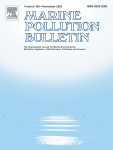Delighted to announce we have a new paper:
Oliveira, A.R., Sardinha-Silva, A., Andrews, P.L., Green, D., Cooke, G.M., Hall, S., Blackburn, K. and Sykes, A.V., 2020. Microplastics presence in cultured and wild-caught cuttlefish, Sepia officinalis. Marine Pollution Bulletin, 160, p.111553.

 www.sciencedirect.com
www.sciencedirect.com
Abstract
Amongst cephalopods microplastics have been reported only in jumbo squid gut. We investigated microplastics in the digestive system of wild cuttlefish (Sepia officinalis) as they are predators and prey and compared the stomach, caecum/intestine and digestive gland (DG) of wild and cultured animals, exposed to seawater from a comparable source. Fibers were the most common type (≈90% of total count) but were ≈2× higher in relation to body weight in wild vs. cultured animals. Fibers were transported to the DG where the count was ≈2× higher /g in wild (median 1.85 fibers/g) vs. cultured. In wild-caught animals the DG was the predominant location but in cultured animals the fibers were more evenly distributed in the digestive tract. The potential impact of microplastics on health of cuttlefish is discussed. Cuttlefish represent a previously unrecognized source of microplastic trophic transfer to fish and finding fibers in cultured animals has implications for aquaculture.
Oliveira, A.R., Sardinha-Silva, A., Andrews, P.L., Green, D., Cooke, G.M., Hall, S., Blackburn, K. and Sykes, A.V., 2020. Microplastics presence in cultured and wild-caught cuttlefish, Sepia officinalis. Marine Pollution Bulletin, 160, p.111553.

Microplastics presence in cultured and wild-caught cuttlefish, Sepia officinalis
Amongst cephalopods microplastics have been reported only in jumbo squid gut. We investigated microplastics in the digestive system of wild cuttlefish…
Abstract
Amongst cephalopods microplastics have been reported only in jumbo squid gut. We investigated microplastics in the digestive system of wild cuttlefish (Sepia officinalis) as they are predators and prey and compared the stomach, caecum/intestine and digestive gland (DG) of wild and cultured animals, exposed to seawater from a comparable source. Fibers were the most common type (≈90% of total count) but were ≈2× higher in relation to body weight in wild vs. cultured animals. Fibers were transported to the DG where the count was ≈2× higher /g in wild (median 1.85 fibers/g) vs. cultured. In wild-caught animals the DG was the predominant location but in cultured animals the fibers were more evenly distributed in the digestive tract. The potential impact of microplastics on health of cuttlefish is discussed. Cuttlefish represent a previously unrecognized source of microplastic trophic transfer to fish and finding fibers in cultured animals has implications for aquaculture.
